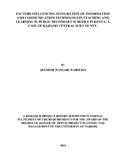| dc.description.abstract | Information communication technology (ICT) is a major drive in most world economies.Hardly any aspect of human endeavor can be effectively carried on without Information communication technologies (ICTs) including education. ICT is now at the center of education reform in line with the technological development of the 21st century. Although schools have had computers for almost two decades, ways to use them effectively have evolved slowly and patchily. Technological revolution in schools has been beset by theoretical inadequacies that have kept educational technology at the margins of the established educational system. This creates a digital divide between the developed countries and the developing countries in relation to integration of ICTs in teaching and learning.
The purpose of this study is; to assess the ICT facilities and infrastructure; to determine Human resource capacity; to establish the school administrative practice and assess the school structure in ICT integration in teaching and learning in public secondary schools in Kajiado Central Sub-County. Descriptive survey design was used to establish the factors that influence the integration of ICT in teaching and learning in public secondary schools in Kajiado Central Sub-County. In 2010/2011, under the Economic Stimulus Programme, Kshs.980 million was allocated for equipping of 5 public secondary schools from each Sub-Constituency with a comprehensive ICT infrastructure. A total of 1021 schools throughout the country benefited. The package included training of 10,500 teachers, 1021 head teachers and 210 ICT champions from the beneficiary schools. The 5 schools constitute 11% of the total population. The Deputy Principal and Subject Heads filled the questionnaire. The principals had a scheduled interview.Questionnaires and interview schedule enabled the researcher to collect data. Piloting was done in one school to test the reliability and validity of the research instruments. The data collected was analyzed using statistical package for social sciences (SPSS). Descriptive statistics such as frequencies, percentages and mean were used to present the results of the study and the general trends; this involved tabulating and describing data. This was followed by a discussion of the finding, drawing conclusions and giving recommendations based on the findings in the study. The study findings revealed that inadequate ICT infrastructure such as number of computers, limited ICT skills and training, limited access to technical support, poor internet connection, and unreliable power supply hinder the integration of ICT in teaching and learning in secondary schools.Despite the school leadership supporting ICT integration, they lacked the ICT knowledge, funds to purchase more computer and to maintain those purchased through the governmentproject. Four years down the line, most of the school still maintained the eleven computers, one projector and one laptop given to them by the government. The study therefore recommends that the Governmentcontinues funding the schools to increase the number of computers. More in-service training for teachers to enhance ICT skills in teaching and learning. Communication Network should be improved to ensure reliable internet connectivity. Rural Electrification should be enhanced to ensure reliable power without rationing. | en_US |

